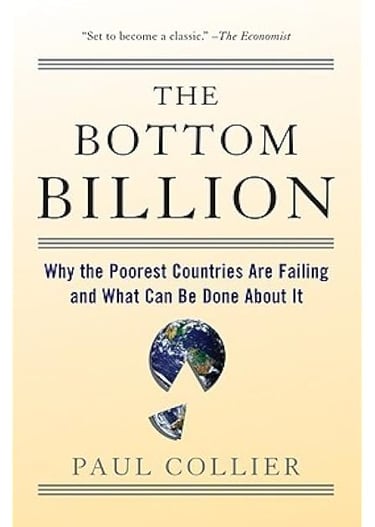The Bottom Billion by Paul Collier, A Book Report
Read a book report on one of our recommended reads, the Bottom Billion by Paul Collier, and further your understanding of developmental economics.
6 min read


The Bottom Billion by Paul Collier, why the poorest countries are failing and what can be done about it, is a take on the subset of our world that, whilst many have experienced rapid growth, have remained stagnant or even regressed. This is what Collier defines as the bottom billion, stating that his aim is not just to identify the problems with these countries, but also offer potential advice on how the world community can help them to catch up despite their adversary.
In this report we highlight the parts of the book that best link to the developmental economics sections of the specification. However, the specification is not only our focus, with The Bottom Billion frequently outlying real-world situations in which the economic theory you will see in the classroom contradicts how events end up turning out.
Part 1: The Traps
The first trap that Collier explores is the conflict trap, which can be divided into civil wars and coups. The key takeaway for civil wars is that that low incomes, slow growth and dependence upon a primary export are both causes and consequences of civil war, hence why so many countries are held in this trap, with the risk of civil war being nearly one in six for every five years. This is only furthered by the interrelation of the causes, with growth increasing incomes and export diversification, or export diversification leading to growth. This, combined with other factors such as the economic cost of a civil war and increases in crime, contribute the continual relapse of bottom billion countries, who contribute to an disproportionately substantial number of global civil wars. Unfortunately, Colliers models do not seem to suggest that this will end any time soon without intervention.
Unlike civil wars, coups are not necessarily as immediately destructive. However, the increased political risk that follows can be detrimental to economic development. Similarly to civil war, coups can be caused be low incomes and slow growth, as well as ethnic dominance, and follow the same trap pattern. However, civil war did not appear to be linked to dependence upon primary exports. This could be because militaries do not necessarily need large finances for their regimes, because they are already paid for by the government. The conflict trap does not just affect a singular country, but the cost to a country AND its surrounding neighbours was estimated at the time to be $64 billion. This is what would previously have been known as the ‘Africa Effect.’
An influx or natural resources can also create a trap. Whilst at first it would appear that increased income should be beneficial to a country by bringing in additional income. However, it can have negative financial and political risks. Export rents can lead to the ‘Dutch Disease’ whereby increased exports appreciate the exchange rate, making other exports uncompetitive thus affecting export diversification and long-term growth. Exports such as oil are also price volatile, so can be unreliable for future projection and development. On a political level, resource rents can also be challenging. In a democracy, resource rents make political patronage relatively more appealing, so can induce corruption. It can also reduce scepticism from the public, allowing for bad policy making decisions. What I found most interesting is how this poses the alternative of an autocracy, which has more freedom to look at long-term outcomes and is free from the political risk that comes with more incentive for rebellion. Collier agrees with this in principle. However, ethnic diversity, as is often seen in the bottom billion, lowers the support base of an autocratic leader, making it less affective. This leads to the solution of a democracy with enough regulation to supress the political risks and encourage appropriate economic management to work around financial risk.
Next is the trap of landlocked with bad neighbours. Being landlocked has obvious restrictions through lower trade to global markets. Lack of ports make trade more costly compared to competitors. However, this is not the limit of the trap for bottom billion countries. In areas such as Africa neighbours can be far from beneficial. The presence of local wars or failing economies restricts trade between these nations and affects the infrastructure that can be used to trade through them. This can then lead to other traps due slow economic growth and low incomes as previously mentioned. As individual countries cannot directly solve this they must rely on regional cooperation, which can present more issues.
The final trap is bad governance in a small country. Poor governance can have obvious consequences on the economy as funds and budgets can be mismanaged and in the worst case stolen. Collier also calculated that the probability of a political turnaround is alarmingly low, at 1.6% per year. This is partly due to the emigration of skilled politicians to pursue a more promising career. There is also a lack of incentive. Corrupt governments understand that to economically progress transparency is needed alongside self-regulation. This means that it is more beneficial to take a lot from a failing economy than none from a more successful one. Yet again, this feeds into other poverty traps. However, countries are more likely to make a sustained turnaround the larger its population, more educated its population and if it had recently emerged from a civil war, presumably due to the drastic shake up of its political system. There is still the need for international organisations in helping to build strong institutions to aid those authentically pursuing development.
Part 2: An interlude- Globalisation to the rescue?
Globalisation has long been seen as the way out for those countries in poverty. They have finally been provided with the opportunity to use their cheaper labour as a comparative advantage to get onto the world stage. This leads to a growth in exports as seen most obviously in China and, when managed correctly, this can be channelled towards growth for the future. However, despite the advantage of cheaper labour, investors still want security to have the confidence to invest. This is where Collier claims that the bottom billion have ‘missed the boat’ of globalisation. The risk of investment in the bottom billion outweighs the current wage gap. It may seem that because wages will increase in the likes of China as they grow, this will eventually provide the chance for the bottom billion, but this isn’t the case due to the economies of scale. Africa suffers from lack of infrastructure for industry, keeping costs high in a perpetual cycle. To fix this would require reforms to trade but this is talked about later in the book.
Part 3: The instruments
Collier begins by evaluating the effectiveness of aid, which has long been the Wests answer to the moral obligation to help the bottom billion. This section provides some horrifying statistics, such as that only 1% of aid in Chad reaches its target destination. This points to multiple problems. Aid is often targeted to the poorest countries, but these are not necessarily those that can benefit most from it. If aid continues going to the poorest countries it may continue to be embezzled or misused. Instead, aid should be targeted to those countries with the most potential for improvement, such as those with as stable government. Aid can also cause the Dutch disease and other issues similar to an influx in natural resource exports. Collier suggests that the solution is aid used to import skills. This can help to stabilise a country before budget supported is provided and helps to counteract Dutch disease as wages are paid in dollars.
Another instrument is military intervention. Collier believes this is necessary despite the bad press of Iraq and Somalia. However, Collier insists that intervention must remain purposeful and strong to have the desired effect, with intervention in Rwanda having been too weak. There remains to be balance though through international cooperation and exit plans best designed to benefit the population.
Next there are international laws and charters. Collier argues suggests that these are a better way to create meaningful change then foreign policy. These would essentially create peer pressure to guide countries towards better policy on issues such as corruption, human rights and environmental protection to increase investor confidence as well as giving the public more opportunity to hold their government accountable to mismanagement. Collier suggests ideas for a charter on natural resource revenues to help long term investment programmes and end corruption often encouraged by companies, a charter on democracy to introduce the watchdogs needed for a successful economy, as is seen in the EU entry requirements, a charter for budget transparency, a charter for post conflict situations to avoid relapse into civil war or disorder and a charter for investment.
Finally, there is trade policy for reversing marginalisation. Collier begins by explaining that whilst trade has its downfalls, it is still the most obvious route out for the bottom billion and can be beneficial. Firstly, rich countries should end the subsidisation of agriculture, for this closes off a large opportunity for comparative advantage. High barriers seen in the bottom billion also restrict trade between them, which could be necessary considering other markets seem increasingly closed off, although this is hard as tariffs are often the easiest form of corruption. Aid also increases imports, meaning trade liberalisation is needed to match an increased demand for exports. These problems cannot entirely be solved through trade liberalisation and diversification, but protection from Asia and international organisation is needed. Collier specifically points to the World Trade Organisation, saying it must be re-structured away from negotiation and towards ‘gifts’ of policy because the bottom billion simply doesn’t have enough to offer at a negotiating table. However, after visiting the WTO I’m not sure if changes like this have already been made.
Part 4: The Struggle for the Bottom Billion
Here Collier lays out his agenda for action, emphasising the need for a multi-faceted approach and coordination between organisations. Finally, he leaves the message that we do not need to be bystanders, and our support for change can also be influential.
contact@economicsrevision.co.uk
© 2024. All rights reserved. Economicsrevision.co.uk accepts no liability related to the use of information contained on the platform.
Reach out:
Support:
support@economicsrevision.co.uk


